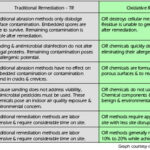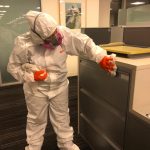Welcome to SERVPRO of West Pensacola, your trusted partner in disaster preparedness and response. In today’s unpredictable world, having a robust and reliable disaster preparedness plan is essential for the safety and continuity of your business. Located at 1101 S Fairfield Dr, Pensacola, FL 32506, our expert team is dedicated to providing comprehensive guidance and top-notch services to ensure that your business is well-equipped to handle any disaster. From storm damage to fire outbreaks, we are here to offer prompt, professional, and efficient response. Let us help you fortify your business against the unexpected, ensuring peace of mind and business continuity. Visit us at https://servprowestpensacola.com/ or call us at (850) 469-1160 for all your emergency disaster needs.
Table of Contents
ToggleRisk Assessment and Planning
Identifying Potential Risks
The first step in developing an effective disaster preparedness plan is to identify potential risks that are specific to your business and location. This includes conducting a thorough assessment of your facility, taking into account factors such as geographical location, weather patterns, surrounding infrastructure, and industry-specific risks. By identifying potential risks, you can better understand the vulnerabilities of your business and develop tailored strategies to mitigate and manage these risks.
Customized Plans
Once potential risks have been identified, it is crucial to develop customized plans that address these risks. This involves creating a comprehensive strategy that incorporates prevention, mitigation, and recovery measures. Each business is unique, and therefore, each disaster preparedness plan should be tailored to the specific needs and requirements of the organization. By customizing your plan, you can ensure that it aligns with your business operations and maximizes the effectiveness of your preparedness efforts.
Prevention Strategies
Prevention is always better than cure, and this holds true in the realm of disaster preparedness. Implementing prevention strategies can help minimize the likelihood of emergencies occurring in the first place. This can include measures such as regular maintenance checks, implementing safety protocols, training employees on hazard identification, and establishing robust security systems. By prioritizing prevention, you can significantly reduce the potential risks and safeguard the continuity of your business.
Mitigation Strategies
Despite the best prevention efforts, emergencies can still occur. This is where mitigation strategies come into play. Mitigation refers to the actions taken to minimize the impact of a disaster. This can involve measures such as reinforcing infrastructure, improving building codes, implementing emergency response protocols, and establishing clear communication channels. By implementing effective mitigation strategies, you can minimize potential damages and ensure a more efficient response during an emergency.
Recovery Strategies
Recovery is the final phase of the disaster preparedness plan. This involves developing strategies and resources to help your business bounce back after a disaster strikes. Recovery strategies can include measures such as creating alternative work arrangements, implementing supply chain management strategies, restoring critical infrastructure, and providing emotional support to employees. By focusing on recovery, you can ensure a smooth transition back to normal operations and minimize the long-term impact of the disaster on your business.
Emergency Response Training
Training Sessions for Employees
One of the most critical aspects of disaster preparedness is ensuring that your employees are equipped with the knowledge and skills to respond effectively during an emergency. Conducting regular training sessions for employees is essential to familiarize them with emergency response protocols, evacuation procedures, and first-aid measures. These training sessions should be interactive and informative, providing employees with practical knowledge and hands-on experience to ensure they can respond calmly and confidently during a crisis.
Evacuation Procedures
During an emergency, quick and safe evacuation is crucial to ensure the safety of employees and visitors. Clearly defined evacuation procedures should be established and communicated to all employees. This includes identifying evacuation routes, assembly points, and designated roles and responsibilities for key personnel. Regular drills and simulations should be conducted to test the effectiveness of the evacuation procedures and identify areas for improvement.
Emergency Contact Information
Having access to accurate and up-to-date emergency contact information is paramount during a crisis. Maintain a comprehensive list of emergency contact numbers for relevant authorities, emergency response teams, and key personnel within your organization. This list should be easily accessible and regularly updated. Additionally, ensure that all employees are aware of the emergency contact information and know how to access it during an emergency.
First-Aid Measures
In the event of an emergency, immediate first-aid measures can make a significant difference in minimizing injuries and potentially saving lives. Train employees on basic first-aid techniques, such as CPR, wound care, and handling medical emergencies. Make sure that first-aid kits are easily accessible and adequately stocked throughout the facility. Designate individuals within your organization as first-aid responders and ensure they receive regular training and certification.
Business Continuity Plans
Developing Comprehensive Plans
Business continuity plans are essential to ensure minimal operational disruption during a disaster. These plans outline the steps and strategies that need to be taken to ensure the continuation of critical business functions and minimize the impact of a disaster on day-to-day operations. When developing a business continuity plan, consider all aspects of your business, including personnel, technology, infrastructure, and supply chain. Assign roles and responsibilities, clearly define communication channels, and establish alternative work arrangements to ensure a smooth continuation of operations.
Minimal Operational Disruption
The primary focus of a business continuity plan is to minimize operational disruption during a disaster. This involves identifying critical business functions and prioritizing their recovery. By conducting a thorough business impact analysis, you can determine the potential impact of a disaster on various aspects of your business and develop strategies to mitigate these risks. This may include implementing redundant systems, establishing backup sites, or securing alternative suppliers. The goal is to ensure that essential services and operations can continue even in the face of adversity.
Backup of Critical Data
In today’s digital age, data is often a critical component of business operations. It is essential to back up critical data regularly and securely. This includes customer information, financial records, operational data, and any other essential files or databases. Implement robust data backup procedures, utilizing both on-site and off-site storage solutions. Regularly test the data restoration process to ensure its effectiveness. By prioritizing data backup, you can minimize the impact of data loss on your business and facilitate a faster recovery.
Alternative Work Arrangements
Disasters can render physical workspaces inaccessible or unsafe. Having alternative work arrangements in place can help ensure that employees can continue working remotely or at alternate locations. Identify critical roles and personnel who can work remotely or from other designated sites. Implement technologies and infrastructure that support remote work, such as virtual private networks (VPNs), cloud-based systems, and secure communication channels. Regularly test these arrangements to ensure their effectiveness and provide necessary training and resources to employees.
Supply Chain Management
Disasters can have a significant impact on the supply chain, affecting the availability and timely delivery of goods and services. Include supply chain management strategies in your business continuity plan to mitigate these risks. This can involve working closely with suppliers to develop contingency plans, diversifying your supply chain, maintaining safety stock levels, and establishing clear communication channels. Regularly review and update these strategies to accommodate any changes in your supply chain or emerging threats.
Regular Maintenance Checks
Identifying Potential Hazards
Regular maintenance checks are essential to identify and address potential hazards within your facility. Conduct regular inspections of the premises to identify any signs of deterioration, wear and tear, or damage that could pose a risk. This can include checking the structural integrity of the building, inspecting utility systems, and identifying potential environmental hazards. By proactively identifying and addressing these hazards, you can prevent accidents and minimize the potential impact of a disaster.
Checking Fire Extinguishers
Fire extinguishers are a critical component of any facility’s fire safety measures. Regularly inspect fire extinguishers to ensure they are in proper working condition. Check for visible signs of damage, such as dents or corrosion, and ensure that the pressure gauge indicates that the extinguisher is fully charged. Train employees on how to use fire extinguishers effectively and conduct regular drills to reinforce this knowledge. Proper maintenance and inspection of fire extinguishers can significantly enhance fire safety measures within your facility.
Checking Alarm Systems
Alarm systems are vital for early detection of emergencies and timely evacuation. Regularly test and inspect alarm systems to ensure they are functioning correctly. This includes checking the integrity of sensors, testing audible and visual alarms, and ensuring proper communication with relevant authorities and emergency response teams. Promptly address any detected issues or malfunctions to ensure the effectiveness of your alarm systems. Regular testing and maintenance of alarm systems can help minimize response time and improve overall emergency preparedness.
Proper Storage of Hazardous Materials
If your business handles or stores hazardous materials, proper storage is of utmost importance to prevent accidents or environmental damage. Regularly review and update your storage procedures to ensure compliance with relevant regulations and industry best practices. Implement measures to prevent spills, leaks, or unauthorized access to hazardous materials. Provide adequate training to employees on handling and storage protocols and conduct regular inspections of storage areas. By implementing proper storage practices, you can significantly reduce the risk of accidents or environmental contamination.
Communication Strategies
Effective Internal Communication
During an emergency, effective internal communication is crucial to ensure that employees are informed and can respond appropriately. Establish clear communication channels within your organization, including designated emergency communication contacts. Implement communication technologies that facilitate real-time updates and enable employees to receive notifications, instructions, and important information. Regularly test these communication channels to confirm their effectiveness and address any identified issues promptly.
Effective External Communication
In addition to internal communication, effective external communication is vital to managing a disaster situation. Establish communication protocols and channels to ensure seamless communication with external stakeholders such as customers, suppliers, and emergency response teams. Provide clear instructions and updates, and facilitate two-way communication to gather essential information and maintain transparency. Regularly review and update your external communication strategies to reflect any changes in technology or emerging communication methods.
Communication with Employees
During a disaster, employees often rely on timely and accurate information to make informed decisions and respond effectively. Regularly communicate with employees to ensure they are aware of the potential risks, prevention strategies, and emergency response procedures. Provide training on how employees can access information and updates during an emergency. Additionally, establish an efficient and reliable system to disseminate critical information, updates, and instructions to employees in real-time.
Communication with Customers
Maintaining open and transparent communication with customers during a disaster is crucial to manage their expectations and ensure their safety and satisfaction. Develop communication strategies to keep customers informed about any disruptions to services, changes in operating hours, or safety precautions. Implement multiple channels, such as email, social media, and website updates, to reach out to customers. Assign dedicated personnel to address customer inquiries and concerns promptly, providing reassurance and support during challenging times.
Communication with Suppliers
Effective communication with suppliers is essential to ensure a seamless supply chain and prevent disruptions to your business operations. Establish pre-established lines of communication with key suppliers and regularly update contact information. Develop contingency plans with suppliers to address potential disruptions and reestablish communication in the event of a disaster. Maintain regular channels of communication to provide updates on operational changes, requirements, and any issues that may affect the supply chain.
Communication with Emergency Response Teams
Collaboration and effective communication with emergency response teams are crucial for a coordinated and efficient response during a disaster. Establish relationships with local emergency response teams, such as fire departments, law enforcement agencies, and medical services. Exchange contact information, participate in joint training exercises, and develop communication protocols. Ensure that key personnel within your organization are trained on how to communicate with emergency response teams and provide them with essential information to facilitate a prompt and effective response.
Recovery Services
Post-Disaster Recovery Services
After a disaster, recovery services are necessary to restore your business to its pre-disaster state. Engage the services of a professional disaster recovery company to handle post-disaster recovery efforts. These professionals are trained and equipped to handle various aspects of recovery, including water extraction, dehumidification, mold remediation, and fire damage restoration. Prompt action is crucial in minimizing the extent of damage and expediting the recovery process. Partnering with a reliable recovery services provider can help ensure a swift and efficient recovery for your business.
Water Extraction
Water intrusion can cause significant damage to your facility and its contents. Prompt water extraction is essential to prevent further damage, mitigate the risk of mold growth, and facilitate the drying process. Professional water extraction services utilize specialized equipment and techniques to remove excess water and restore the affected area. They also conduct thorough inspections to identify any hidden moisture and ensure a complete and efficient extraction process.
Dehumidification
Excessive moisture in the air can prolong the drying process and create an environment conducive to mold growth. Dehumidification is a crucial step in the recovery process to remove excess moisture and restore optimal humidity levels. Professional dehumidification services use advanced equipment to regulate moisture levels and expedite the drying process. This helps prevent further damage, minimize the risk of mold growth, and support the overall recovery efforts.
Mold Remediation
Mold growth is a common consequence of water damage and can pose significant health risks to occupants. Mold remediation involves the removal and treatment of mold-infested areas to ensure a safe and healthy environment. Professional mold remediation services employ specialized techniques and equipment to detect and eliminate mold, identify the root cause of the mold growth, and implement preventive measures to mitigate future occurrences. Timely mold remediation is critical to prevent further damage and ensure the safety of your employees and customers.
Fire Damage Restoration
Fire outbreaks can cause widespread damage to your facility and its contents. Fire damage restoration services specialize in repairing and restoring areas damaged by fire and smoke. These professionals have the expertise and equipment to remove soot and smoke residue, repair structural damage, and restore salvageable items. Fire damage restoration services also conduct thorough inspections to assess the extent of the damage and develop a customized restoration plan. Engaging the services of fire damage restoration professionals can help expedite the recovery process and minimize the impact of fire damage on your business.
Minimizing Damage
Taking immediate action to minimize damage is crucial during a disaster. Engage the services of a reputable disaster recovery company that offers expedited response times to minimize the extent of damage. Professionals experienced in disaster recovery have the knowledge and resources to assess the situation, prioritize actions, and implement strategies to mitigate further damage. By promptly addressing issues such as water intrusion, fire damage, or mold growth, you can significantly reduce the impact of the disaster on your facility and its contents.
Expedited Recovery
A swift and efficient recovery is essential for business continuity. Disaster recovery professionals specialize in expedited recovery, utilizing advanced techniques and equipment to restore your facility and its operations as quickly as possible. By partnering with a reliable recovery services provider, you can minimize downtime, reduce financial losses, and ensure a smooth transition back to normal operations. These professionals work closely with you to develop a tailored recovery plan that addresses your specific needs and timelines.
Insurance Liaison
Guidance on Insurance Claims
Navigating the insurance claims process can be complex and time-consuming, especially during a disaster. Disaster recovery professionals can offer guidance and support throughout the insurance claims process. They can help you understand your insurance coverage, document the extent of the damage, and gather the necessary evidence and documentation. By partnering with a reputable disaster recovery company, you can ensure that your insurance claims are properly processed, reducing the burden on your organization and expediting the recovery process.
Documentation for Processing
Accurate and comprehensive documentation is crucial for insurance claims processing. Disaster recovery professionals can assist you in documenting the extent of the damage, including photographic evidence, detailed reports, and itemized inventories. These professionals have the expertise to identify and document both visible and hidden damages, ensuring that all losses are accounted for during the claims process. Their knowledge of insurance requirements and protocols can help streamline the documentation process and increase the likelihood of a successful insurance claim.
Working with Insurance Companies
Effective communication and collaboration with insurance companies are essential for a smooth insurance claims process. Disaster recovery professionals can act as a liaison between your organization and insurance companies, ensuring clear and accurate communication. They can assist in compiling all necessary documentation, answering queries from insurance representatives, and advocating for your organization’s best interests. By working closely with insurance companies, you can maximize your chances of receiving the coverage you are entitled to and expedite the resolution of your insurance claim.
Regular Updates and Reviews
Periodic Reviews
A disaster preparedness plan should be a living document that evolves with your organization and the changing threat landscape. Conducting periodic reviews of your disaster preparedness plan is essential to ensure its relevance and effectiveness. Regularly assess the plan’s objectives, strategies, and procedures, and update them as necessary. Consider factors such as emerging threats, changes in technology, and lessons learned from past incidents. By conducting regular reviews, you can ensure that your plan remains current and aligned with your organization’s goals and objectives.
Updating the Plan
Disaster preparedness plans should reflect any changes in your organization’s operations, infrastructure, personnel, or regulatory requirements. Regularly update your plan to incorporate these changes and ensure its accuracy. Assign a designated team or individual responsible for updating the plan and disseminating updated versions to relevant stakeholders. Once the plan has been updated, conduct training sessions and drills to familiarize employees with the revised procedures and strategies.
Reflecting Changes
Risk landscapes are constantly evolving, and it is essential to reflect these changes in your disaster preparedness plan. Regularly assess emerging threats, such as cyber risks, climate change, or political instability, and update your plan accordingly. Engage with industry experts, regulatory agencies, and emergency response teams to stay informed about the latest developments and best practices. By adapting your plan to reflect changes in the external environment, you can ensure that your organization remains resilient and well-equipped to handle any disaster.
Emerging Threats
As new threats and vulnerabilities emerge, it is crucial to incorporate them into your disaster preparedness plan. Stay informed about the latest trends and emerging risks within your industry and geographic location. Engage with industry associations, attend conferences and seminars, and leverage the expertise of disaster preparedness professionals to better understand emerging threats and their potential impact on your organization. By proactively addressing emerging threats, you can enhance your organization’s preparedness and ensure a more robust response during a disaster.
In conclusion, a comprehensive disaster preparedness plan is vital for the safety and continuity of your business. By incorporating risk assessment and planning, emergency response training, business continuity plans, regular maintenance checks, communication strategies, recovery services, insurance liaison, and regular updates and reviews into your plan, you can enhance your organization’s preparedness and resilience. Partnering with professionals such as SERVPRO of West Pensacola can provide valuable guidance and support throughout the process, ensuring that your business is well-equipped to handle any disaster and maintain continuity in the face of adversity. Don’t wait for a disaster to strike—start fortifying your business today.














